The title begs the question, ‘what is a big river?’ To me, a big river is one where you can’t see the bottom on the far bank, no matter how clear the water is. Really though, a big river can mean different things to different anglers, so for the sake of this article let’s say that the big rivers I’m writing about are the bigger spate rivers that turn chocolate brown at times of flood. The ones I’ve fished regularly over the years are the Severn, Trent, Wye and Ribble.
Location
Fish-spotting is not easy on big spate rivers. Even in clear water conditions the water is never anywhere near as clear as it is on the chalk streams. So what we have to do on spate rivers is read the water’s surface.
Barbel will visit all types of swims, from fast rapids to slow, almost still pools. In fact, they will seek food anywhere they think they can find it when it suits them to do so. Never rule out anywhere is the answer then, but it is wise to start with the most likely swims in a given set of conditions, working your way down to the least likely. A rule of thumb is to choose fast, oxygenated water in early season when the conditions are warm and there has been little rain for several weeks. Fast water will most often be shallow, which means it will also be weedy, and that too is a good place to fish for barbel. In near-bank swims you can try to spot the fish, which is a lot easier if you have a decent pair of polarised glasses, and I mean a decent pair. There is a lot of rubbish around; cheap, coated lenses instead of the proper job where the polarising is built into the lens itself. I have a pair made to my prescription. They’re not cheap, but if you want the best then you have to pay for it.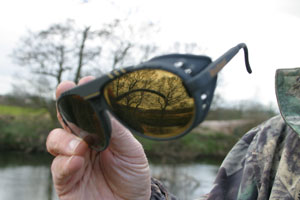
Prescription Polaroid Glasses
In large rivers, though, as I said earlier, it is usually a case of reading the surface water, and finding the weed in shallow water, and laying traps with bait. Let me describe what my ideal barbel swim looks like, bearing in mind that it is not necessarily the best swim to catch big barbel, but probably the best swim to make a catch of barbel, which may or may not have one or two big barbel amongst them.
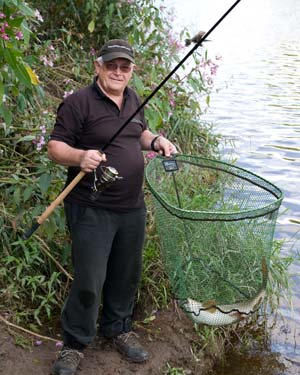
One in the net on the Wye
I look for a steady flow of not too shallow water, say 4ft to 8ft deep, that breaks up fairly quickly as it hits a rapid rise in the river bed. If there are weedbeds with channels 3ft or more wide between them then so much the better. And if this feature happens to be on a bend as well, forming a pool of fairly slack water, then that is the cream on the cake! The exact spot to fish, or it usually is but, don’t forget, there is always room to experiment, is just before the water breaks up, along the crease that will be formed between the flow and the pool. If there is no pool then fish in the clear channels between the weed, again just before the water breaks up.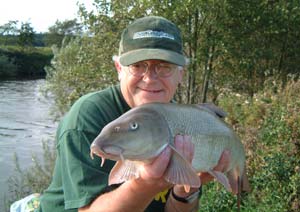
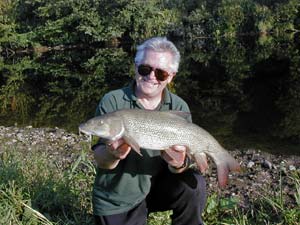
Barbel from the Lower Severn and the Ribble
Any swim with a steady flow, weedy or otherwise, providing you can get a bait on the bottom, will produce barbel. Where the surface water is part smooth and steady, but with faster water forming a crease, it is usually right on the crease where the hot-spot lies.
Big barbel generally like slacker water. Perhaps this is because they grow lazier as they grow bigger. Or maybe they have been lazy all their lives and are big because they chose to live most of their lives in slacker water and have never had to expend the same amount of energy as the smaller ones. Everywhere I’ve caught big barbel, and by big I mean big according to the average size of barbel found in a particular river, which could be 7lb in one river and 10lb and more on another, they have consistently come from slower, steadier water, and usually water with a little more depth than average in that particular stretch. The downside is that they are usually the most difficult barbel to catch, not simply because of their size, but because there are fewer of them. You have to wait longer for bites, but when you do get a bite chances are it will be from one of the biggest fish in that stretch.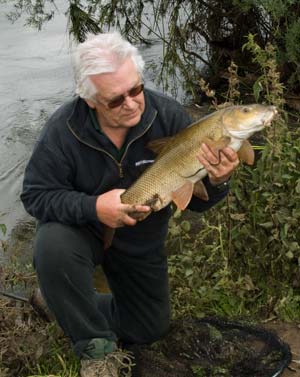
Barbel from the upper Trent
All barbel love snags in any shape or form, but particularly fallen trees and branches. Don’t fish such areas unless you are prepared to use tackle that can pull them out. And that applies no matter if you are targeting big barbel or small barbel – they can all fight hard enough to make short work of flimsy tackle. Small barbel make up in speed and aggression for what they lack in weight.
Tackle
Much of the time a purpose-built barbel rod will do a great job, one that is not too heavy, with a medium-fast to through action will give you maximum pleasure when playing barbel, for it will bend through most of its length yet retain the power required to subdue a good fish. For heavy swimfeeder work, however, especially on the wider reaches of really big rivers like the middle and lower Severn, a heavier rod is required, perhaps one of the lighter carp rods, that will chuck a heavy, loaded feeder. One of the rods I use currently is the FishingMagic one that was given to me by the FM members when I retired from the full time editing of this website. It’s a beautiful rod, based on a Harrison’s Torrix blank and built to my personal specifications by Mark Tunley. It’s 12ft long and 1.75lb test curve.
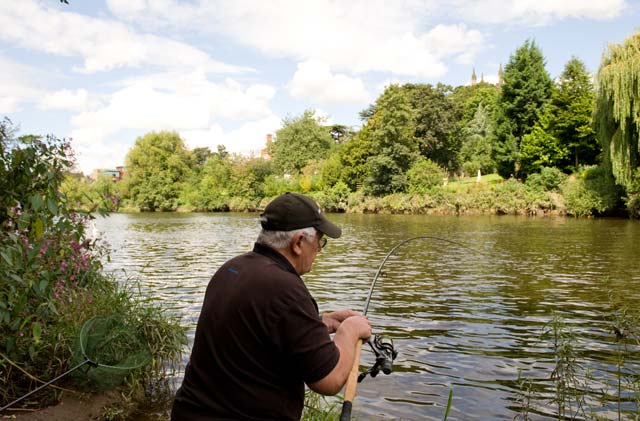
Bending into a Wye barbel
In these days of low diameter, braided and pre-stretched mono lines, I can’t see the point in fishing anything less than 10lb line on the reel when barbel fishing, even for the smaller barbel of some rivers. A 10lb reel line to a 10lb hooklength (the knot will be the weak link) is as light as you need to go for most barbel in open water, with a step-up of 2lb on both reel line and hooklength for snaggy swims. The main line can be a braid if preferred, with either a braid or mono hooklength. My own preference these days is for a tough mono to a fluorocarbon hooklength.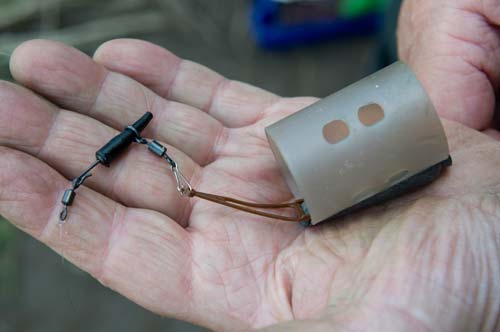
My standard barbel rig (for feeder or bomb)
Rather than try to describe the barbel rig I most often use take a look at the picture above which should be self explanatory. Both the swimfeeder or bomb and the hooklength can be changed in seconds. The rig can be set to be free-running or the large ring on the swivel pushed firmly onto the tapered sleeve to make it a bolt rig. In either case the rig is completely non-tethering. I cover the two connections with silicon tube when fishing but for clarity have left them off to take this picture.
Baits
In the early season, especially when the water is running clear, there is little to beat the hemp and caster combination, fished with a suitable block-end feeder with the holes either opened up or taped over to adjust the dispensation rate according to flow and barbel appetite. Of course, baits like sweetcorn and luncheon meat will catch too, but there is little, if anything, to beat hemp and caster for working up a shoal of barbel into a feeding frenzy. Suitable only for smaller barbel of course as we are not easily able to use casters on a hook that is substantial enough to safely handle double-figure fish. There are workarounds too, such as the Korda Maggot klip and gluing casters and maggots to hairs.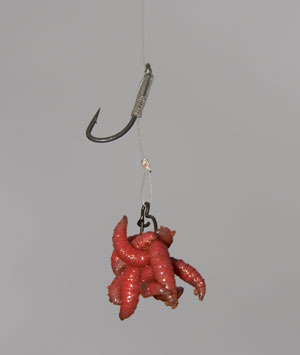
Maggots mounted on thge Korda Maggot Klip
In darkness, or when the river is carrying colour, large, smelly baits come into their own. Flavoured luncheon meat and so-called designer pastes, Peperami sausage, meatballs and other meaty products all have their day. Large lobworms and bunches of small redworms are always worth a try in coloured water too. Plain luncheon meat is still a good bait but I think it has an edge in these days of heavy pressure on some barbel swims with the addition of some flavour. Alternatively, Campbell’s Meatballs offer a good alternative, either straight from the can or flavoured. I’ve had great success flavouring them with various powders, such as tikka and garam masala, from the local supermarket.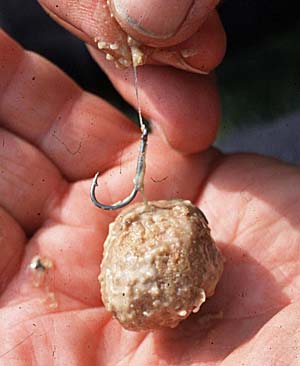
Meatball mounted in a soft hair-rigged bait band
Top of the tree though has got to be pellets and boilies, halibut pellets and boilies based on some kind of seafood or meat flavour like crab are favourite, but I’ve had plenty of barbel on fruit and sweet flavoured boilies so don’t think you have to use the almost mandatory fishy and meaty ones. Pellet or boilie, which is best? Sometimes I think it’s all in the mind, our minds, not the barbel’s. Fish either boilies or pellets well and both will catch, so choose whichever you have the most confidence in.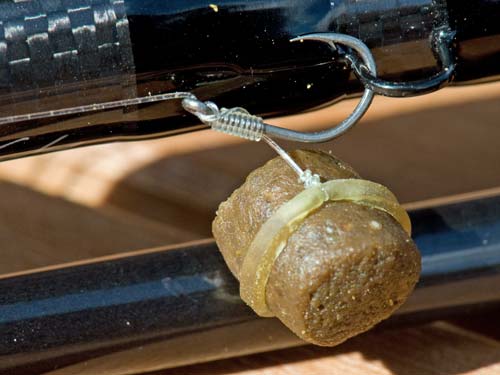
Halibut pellet mounted in a tight hair-rigged bait band
Method
When fishing the feeder, casting regularly to keep a trickle of feed going through the swim at all times is essential, otherwise there is no point in using a feeder. A bomb and a PVA bag become a better option if you’re only casting infrequently.
A final few thoughts
One of the best aspects of big rivers is that they usually hold more fish than small rivers, but the fish will be harder to find. One of the worst things about a big river is that they can be daunting to the inexperienced. But think on this: when you’ve done your spadework and fished a few times, and narrowed down a big river to a hot swim, that foreboding, possibly off-putting big river disappears, and there’s just you and a relatively small swim to focus on.
Obviously, this article only scratches the surface of fishing big rivers for barbel, but at least it gives you the basics to plan a campaign. Within these pages of FishingMagic you’ll find lots of articles about fishing for barbel on both big and small rivers, many of them dealing with the finer detail that is missing from this one. Barbel are very exciting fish to target, offering enough problems to make them interesting, a size to put a good bend in your rod, and with a fight to place that bend in the ‘frightening’ category.
I recently enjoyed a few hours on the river Lugg with Paul Williams and Dave Cooper. The Lugg is not a big river, but wherever you catch them from, big or small rivers, barbel have what it takes to offer anglers the best kind of sport.
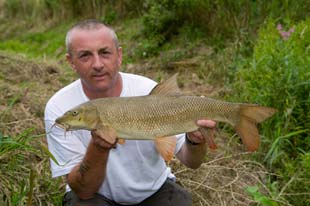
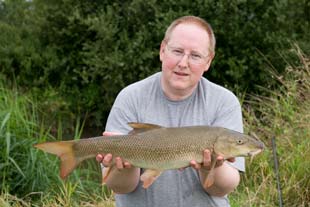
Paul ‘Brummie’ Williams and Dave ‘Coops’ Cooper with a brace of nice barbel from the Lugg
The best part of the season for barbel fishing, late summer and autumn, is just coming up – good luck!










